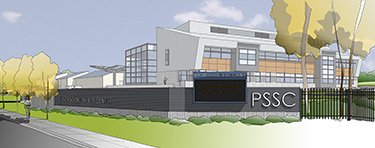|
Subscribe / Renew |
|
|
Contact Us |
|
| ► Subscribe to our Free Weekly Newsletter | |
| home | Welcome, sign in or click here to subscribe. | login |
Architecture & Engineering
| |
 |
October 27, 2016
Survey: Hutteball & Oremus Architecture
Specialty: School design and planning
Management: Principals Kevin Oremus, Bill Chaput and Steve Busig
Founded: 1995
Headquarters: Kirkland
2015 revenues: N/A
Projected 2016 revenues: N/A
Projects: Puget Sound Skills Center Health Sciences Building, Burien; Anacortes High School, Anacortes; Marysville-Pilchuck High School Food Commons, Marysville
Principals Kevin Oremus, Bill Chaput and Steve Busig responded to questions about their projects and trends in the education sector.
Q: What are a few of the hallmarks of the projects you design?
A: We create unique educational facilities that give students ownership of their learning.
Currently, at Anacortes High School the student-centered learning environment includes manufacturers, robotics and inventors labs, providing students with access to the types of program-specific facilities that allow them to explore a multitude of career path choices.
At Marysville-Pilchuck High School, the design for the new Food Commons incorporates a student store for students who wish to explore business and marketing applications.
Integration of non-traditional curriculum into traditional curriculum is becoming more prominent, and we embrace the opportunity to give our clients the spaces that will bring the most success to their students.
Q: Which recent project are you most proud of and why?
A: An exciting project we are working on is the Puget Sound Skills Center Health Sciences Building opening in fall of 2017.
Along with host district Highline Public Schools, five other surrounding districts send their students to this center to gain professional experiences in trades such as nursing, fire and emergency, dental, and more.
The Health Sciences Building will double capacity of the nursing and dental programs, decreasing the wait lists for these programs. Providing students with a state-of-the-art facility, filled with professional equipment and practicing professionals, (will give them) access to invaluable opportunities. The design will welcome current students, attract prospective students and provide a professional building to encourage all attending students to adopt a professional attitude and outlook as they transition to health care professionals.
Q: What are some changes in the educational sector over the past few years?
A: Districts now understand that students and teachers need more than just classrooms. Learning styles have evolved from passive to active learning. There is more emphasis on creativity, originality, performance and innovation in modern day classrooms.
With this realization, districts have a holistic view when approaching the design of new schools. Breakout spaces, student-only conference rooms, cyber bars and other spaces are being used to augment the classrooms and to enhance collaborative learning by students.
Today’s students are also learning through mobile devices such as laptops and tablets. Our designs are incorporating more outlets and charging cubbies to provide the support students need to keep their devices properly charged.
We have also seen that community members are more involved than ever before. They are part of the process from the beginning, participating in community meetings to express their opinions about student needs as well as community needs. Their pride of their community shines through as they help us design a facility that is functional both during and beyond school hours.
Q: What are common misconceptions about the school design and building process?
A: We tend to find that the biggest misconception is the price tag that comes with building or modernizing a school.
Schools carry a lot of financial burden to support the multitude of programs that are offered. With an increase in the number and types of programs offered comes an increase to the cost of the building.
We work closely with our district partners to prioritize wants and needs and balance them with the budget, ensuring the best educational environment will be built for their students.
Q: What’s a big business concern looking ahead to 2017?
A: Our ability to work mobilely and remotely for the benefit of our employees and our clients.
Our service-driven work model requires that we spend more time on site and away from the office during all project phases. To improve our efficiency, performance and provide flexibility when needed, our staff relies on mobile technologies to maintain their work flow and communicate with both consultants and clients.
Other Stories:
- Healthy buildings start with healthy materials
- Survey: Rolluda Architects
- Survey: The Blueline Group
- Survey: Innova Architects
- Survey: McKinstry
- Senior designers, new architects learn from one another
- Is Passive House the solution to our climate crisis?
- National crisis grows as infrastructure crumbles away
- A new engineer’s guide to consulting in Central Washington
- Art tree depicts U District project’s community link
- Interviewing for that big job? Here are 5 tips
- Survey: CollinsWoerman



